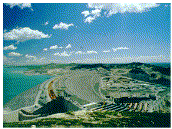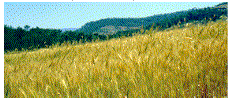| The
Southeastern Anatolia Project (GAP) is being implemented in the
Southeastern Anatolia Region which lies to the south of the Eastern
Taurus Mountains. The region is a vast area composed mainly of
plains and borders on Iraq in the southeast and Syria in the south.
The project area consists of the provinces of Sanliurfa, Mardin,
Gaziantep, Adiyaman, Diyarbakir, Siirt, Batman and Sirnak and covers
75,256 square kilometers accounting for 9,7 percent of the nations
territory. Its population was 5.274.644 in 1990, or 9.3 percent of
the total national population.
The area was one of the first to be
settled in known history, and was part of the region called the
"Fertile Crescent." Fertile soil and favourable climatic
conditions encouraged agriculture and civilizations thrived.
However, in modern times, the region lost its previous glory. It
lapsed into relative backwardness due to its unfavourable location
with respect to markets and supply of material inputs and due to the
scarcity of rainfall which made the practice of modern agriculture
difficult and risky. To rectify the situation, GAP was started with
the intent of increasing agricultural production and exploiting the
hydro-power potential.
GAP is the largest project ever
attempted in Turkey, and one of the largest in world. Its total cost
is estimated to be about 26 billion US Dollars.
As an integrated project, GAP
comprises dams, power plants, irrigation schemes, agriculture,
transportation, industry, education, health and urban and rural
infrastructure.
Under 13 subprojects, the GAP
involves 22 dams and 19 hydroelectric power plants on the Euphrates
and the Tigris rivers. Some of these structures and facilities have
already been built, and some are under construction. Upon completion
of the project nearly 1.7 million hectares of land will be irrigated
and 27 billion Kwhs of electricity will be generated annually with
an installed capacity of 7.500 MWs.
 Ataturk
Dam on the Euphrates was completed in 1990 and its reservoir is
capable of holding 48.5 billion cubic meters of water. The dam ranks
as the 9th largest in the world in terms of volume of the embankment
and 22nd largest in terms of reservoir capacity. Ataturk
Hydroelectric Power Plant has an installed capacity of 2.400 MW and
will annually generate 8.900 Gwh of electricity. The power plant
became fully operational in December, 1993. Ataturk
Dam on the Euphrates was completed in 1990 and its reservoir is
capable of holding 48.5 billion cubic meters of water. The dam ranks
as the 9th largest in the world in terms of volume of the embankment
and 22nd largest in terms of reservoir capacity. Ataturk
Hydroelectric Power Plant has an installed capacity of 2.400 MW and
will annually generate 8.900 Gwh of electricity. The power plant
became fully operational in December, 1993.
Water from the Ataturk Dam reservoir
will be diverted to the plains of upper Mesopotamia via the
Sanliurfa Tunnels system which consists of two parallel tunnels each
26.4 kms long and 7.62 meters in diameter. These are the longest
tunnels in the world built for irrigation purposes. One of the
tunnels completed in 1995 and the other will be completed in 1996.
Irrigation started in the Harran Plain in the spring of 1995.
GAP will create opportunities for
diversifying the crop pattern and increasing the quantity of
agricultural production of the region. It will be possible to obtain
2-3 crops each year under irrigated conditions rather than just one
as is the case presently. New crops like soya-beans will be
introduced and production of some crops will increase appreciably.
For example, by the early 2000s, cotton production in the region is
expected to exceed what the whole country produces today.
Investment areas which have the
greatest potential in the region are as follows:
- Frozen foods
- Vegetable oils
- Packing and storage facilities
- Dry fruits processing
- Integrated livestock production (slaughtering, meat, milk
processing)
- Integrated poultry production
- Cotton yarn
- Cotton clothing
- Woolen yarn
- Leather industries
- Clothing industries
- Furniture establishments
- Packaging materials (wooden, polypropylene and others)
- Pesticides and herbicides
- Fertilizers
- Construction materials (concrete blocks/ready made concrete
products, tiles and bricks, cement pipes)
- Printing and publishing
- Textile machinery
- Agricultural machinery and equipment
- Nurseries for apricots, grapes and peaches
- Seed production farms for vegetables and food legumes
- Export oriented vegetables production
- Greenhouse establishment
- Vegetable seeding
- Vegetable and fruit canning and processing
- Wheat flour, macaroni, semolina
The policy of the government is to
promote private investments and increase the role of the private
sector in the region's industrialization process. Foreign capital is
very much welcome. There are opportunities for foreign capital in
dam, power plant, motorway and railway construction on a
build-operate-transfer (BOT) basis. Urbanization, population
increase, and the desire for better housing as incomes rise, will
also give impetus to the construction sector.
The most promising investment areas
in the region are agro-industries and agricultural input producing
industries. The region is expected to be a major exporter of
agro-products to the other regions of the country and abroad. This
will create opportunities for investment in storing, sorting and
packaging facilities and transportation. It is expected that
especially textiles and food processing will attract large amounts
of capital from outside the region.
The point of contact for getting more
information about the GAP, and investment possibilities in the
region is the GAP Regional Development Administration which is
responsible for planning, programming and coordinating the regional
development efforts. The Administration's headquarters is in Ankara
and its regional directorate is in Sanliurfa.
|

